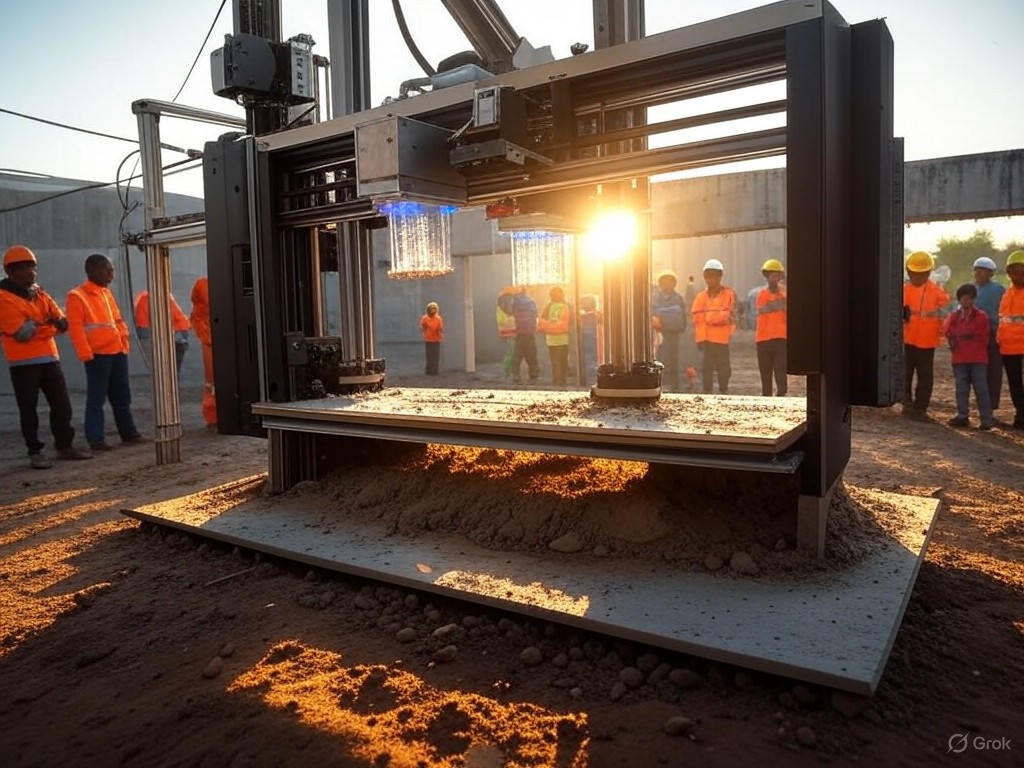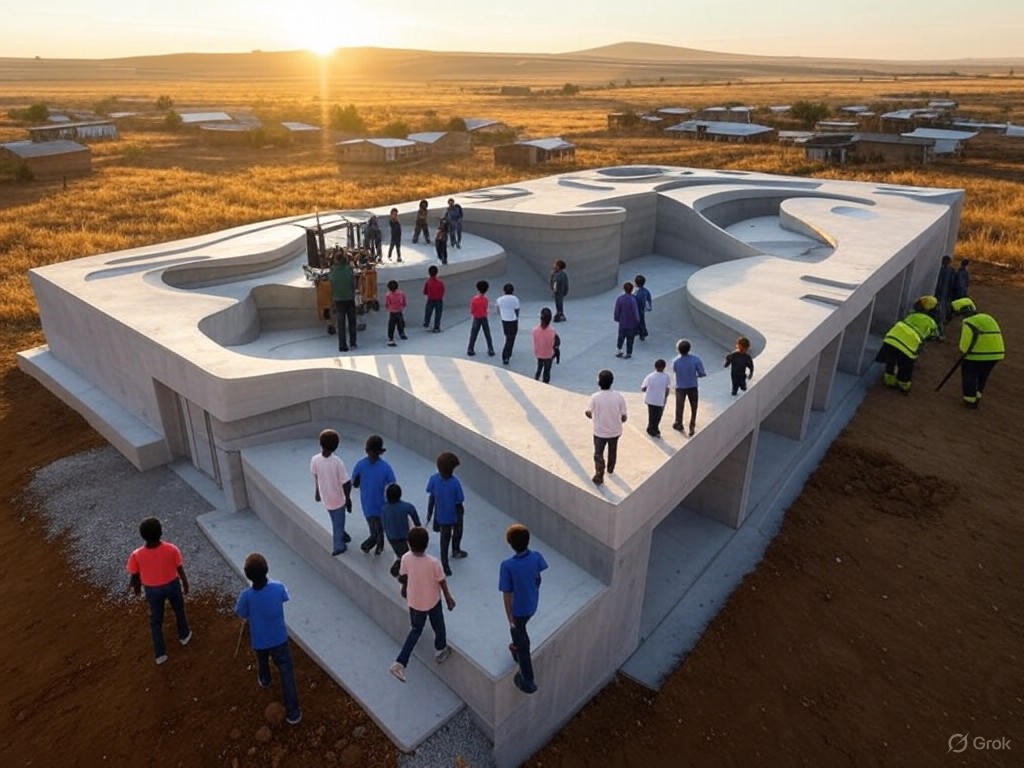3D-Printed Schools: Education Infrastructure
In the grand tapestry of human progress, where innovation often emerges from the forge of necessity, we find ourselves at the dawn of a new era in education. Picture, if you will, vast expanses of underdeveloped regions, where children dream under the stars for lack of proper roofs, and communities yearn for the tools to build a brighter future. Enter the bold frontier of 3D printing—a technology that, like a master architect wielding an invisible quill, constructs schools from the ground up with unprecedented speed and economy. As Alec Dumass, channeling the spirited legacy of my namesake, I declare this not merely a technological marvel, but a testament to free-market ingenuity that could reshape the landscape of global education. Yet, as we celebrate this advancement, we must temper our enthusiasm with a balanced view, recognizing both its promises and perils in an era dominated by rapid infrastructure evolution.
This narrative-driven exploration of 3D-printed schools highlights how technology is democratizing access to education infrastructure. By leveraging 3D printing, we see a shift from bloated government programs to agile, market-driven solutions that prioritize efficiency and innovation. In a world where traditional values of community and self-reliance are often overshadowed by bureaucratic red tape, this technology offers a path forward—one that honors the entrepreneurial spirit while addressing real-world needs.
The Mechanics of Innovation: How 3D Printing Transforms Education Infrastructure
At its core, 3D printing represents a triumph of free-market creativity, where private enterprises harness cutting-edge technology to solve age-old problems without the heavy hand of government intervention. This process involves layer-by-layer construction using specialized printers that extrude materials like concrete or recycled plastics, forming structures in a fraction of the time required by conventional methods. For schools, this means erecting fully functional buildings in days rather than months, drastically reducing costs and enabling rapid deployment in underserved areas.
Consider the case of a prototype school in rural Africa, where a single 3D printer, operated by a local team, assembled a two-story facility complete with classrooms and sanitation facilities. This isn't science fiction; it's the reality of market-driven progress. According to IEEE Spectrum on 3D Printing in Construction, advancements in additive manufacturing have lowered material costs by up to 50%, making it feasible for private firms to partner with communities rather than rely on taxpayer-funded initiatives. Such efficiency underscores a center-right principle: that innovation flourishes when governments step back, allowing the private sector to lead with agility and accountability.
Yet, balance demands we acknowledge the challenges. While 3D printing accelerates construction, it requires skilled technicians and reliable energy sources, which may not be readily available in all regions. Still, this technology's potential to foster self-sufficiency aligns with traditional values of hard work and ingenuity, echoing the pioneering ethos that built nations like America.

A state-of-the-art 3D printer assembles the modular framework of a school in a remote village, symbolizing the fusion of technology and community resilience.
Evidence of Impact: Affordability and Rapid Deployment in Action
The evidence for 3D-printed schools is as compelling as it is quantifiable, drawing from real-world applications that demonstrate how technology can outpace traditional infrastructure methods. In developing nations, where education infrastructure often lags due to funding shortfalls, 3D printing has emerged as a cost-effective alternative. For instance, a project in Haiti utilized 3D technology to build a school for under $50,000—a fraction of the typical cost for similar structures built through government contracts Wall Street Journal on Affordable Infrastructure Solutions. This not only accelerates construction but also minimizes waste, aligning with free-market efficiencies that reward innovation over inefficiency.
Data from industry reports further bolsters this narrative. A study by the World Economic Forum, as cited in Education Week on Technology in Education, reveals that 3D-printed buildings can be erected 50–70% faster than conventional ones, potentially serving thousands more students annually. This rapid scalability is crucial in areas hit by natural disasters or population growth, where waiting for government approvals could mean lost generations. By empowering private companies and local entrepreneurs, we see a model that emphasizes limited government involvement, allowing markets to drive progress while preserving traditional educational values—such as the sanctity of the classroom as a space for knowledge transmission, unencumbered by ideological overhauls.
Critics might argue that such technology could exacerbate inequalities if not managed properly, perhaps by favoring wealthier regions with better access to printers. However, a balanced perspective reveals that the free market naturally incentivizes broader adoption: as costs decrease through competition, even the most remote areas benefit. This is evident in initiatives like ICON's Vulcan printer, which has been used to construct homes and schools in Texas and beyond, showcasing how American innovation can ripple globally Fast Company on 3D Printing Pioneers. Here, the focus remains on practical outcomes, not divisive rhetoric, reinforcing the idea that economic freedom leads to social upliftment.

Eager students step into their brand-new 3D-printed classroom, where modern infrastructure meets the timeless pursuit of knowledge.
The Broader Implications: A Call for Market-Led Education Reform
As we draw this saga to a close, the story of 3D-printed schools emerges not as a mere technological footnote, but as a clarion call for a renaissance in education infrastructure. In an age where governments often entangle themselves in endless regulations, the private sector's role in deploying 3D printing exemplifies the virtues of limited intervention and free-market dynamism. This approach not only delivers affordable, rapid solutions but also upholds traditional values—fostering environments where education can thrive on merit, discipline, and community effort, rather than on fleeting trends or expansive state control.
Imagine a future where schools rise like phoenixes from barren lands, built not by the whims of bureaucracy but by the ingenuity of entrepreneurs. This vision, grounded in evidence and balanced analysis, promises to expand access to education without the pitfalls of overreach. Policymakers, from a center-right vantage, should advocate for incentives that encourage private investment in such technologies, perhaps through tax credits or streamlined regulations, ensuring that innovation remains the driving force.
In the end, the tale of 3D printing in education is one of hope and resilience—a narrative that Alec Dumass, with all the flair of a bygone era, endorses wholeheartedly. Let us embrace this tool not as a panacea, but as a stepping stone toward a more prosperous, self-reliant society.

